Historic Amherst, New Hampshire
A winter visit to the charming, historic village of Amherst, New Hampshire, including the town common, colonial architecture, and local landmarks.
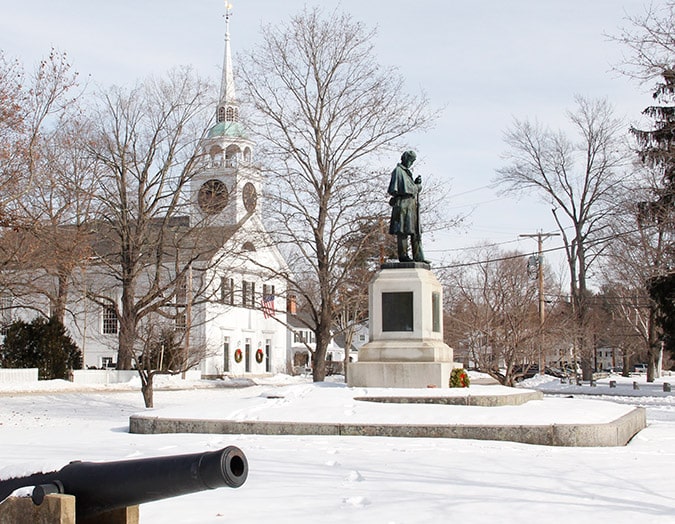
Coffee By Design | Portland, Maine
Photo Credit : Katherine KeenanVenture about 15 miles southwest of Manchester — the Granite State’s largest city — on Route 101, and you’ll happen upon the village of Amherst, New Hampshire. Originally chartered in 1728, the Common anchors this small hamlet, inviting visitors to explore the historic architecture and landmarks that spread out from its town green.
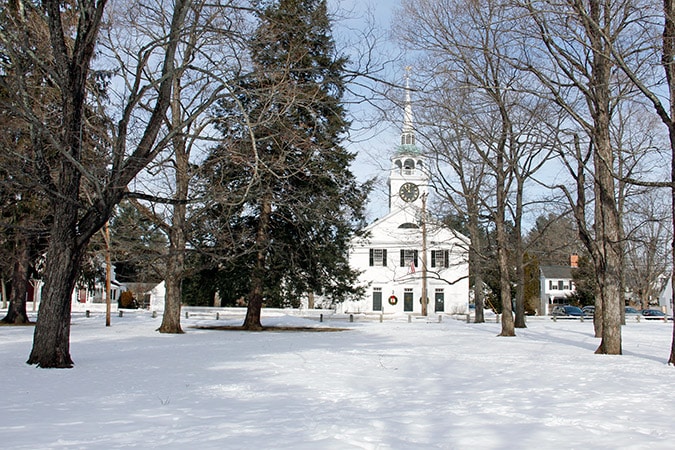
Photo Credit : Brenda Darroch
Most folks might choose to visit Amherst in one of the milder months, but the January freeze was in full effect—temperatures having dipped down to single digits — on the day I headed there to meet my tour guide, former resident Alyson Horrocks.
Armed with the knowledge of a local combined with historical tidbits plucked from the pages of Walking Tours of Amherst Village, a publication offered by the Historical Society of Amherst, Alyson guided me around the heart of the town, beginning with its sizable common in the part of the village known as the “The Plain.”
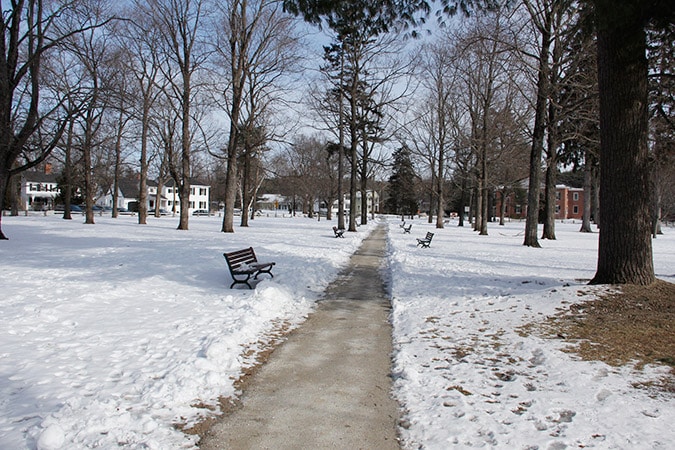
Photo Credit : Brenda Darroch
Town commons established in the 18th century, or village greens as they’re more commonly known today, were thought to have been used for militia training, the grazing of livestock, and, at times, public punishment. Encircled by a fence in 1866, Amherst’s Common was dedicated as a park in 1868 and remains so today, retaining many of the icons that grace town centers throughout New England’s countryside.
Monuments scattered about a green offer a narrative of a town’s past — like that cube of granite with the hook poking out of its top that’s alleged to have been a whipping post. But equally telling is what’s not there. In this case, the ubiquitous gazebo is noticeably absent. According to the historical society, residents resisted erecting such a structure in an attempt to avoid the “Victorianization” that was occurring in neighboring towns.
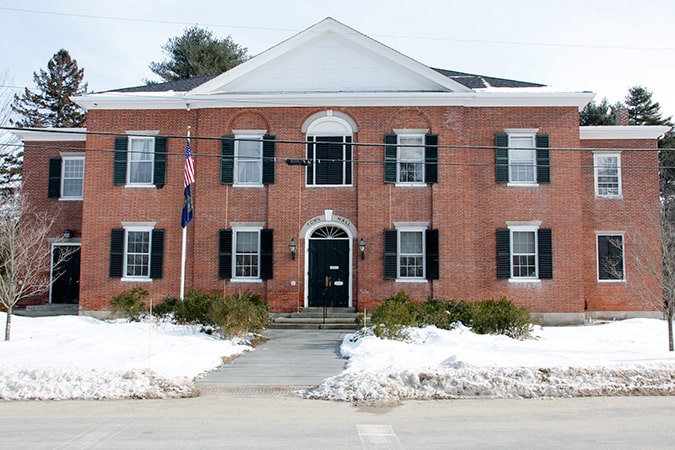
Photo Credit : Brenda Darroch
Our tour started at the Third County Courthouse — now the town hall — and Old Burying Ground set on the east side of the Common. The first markers dating back to 1735 were fieldstones, but those were difficult to find under the fresh fall of snow.
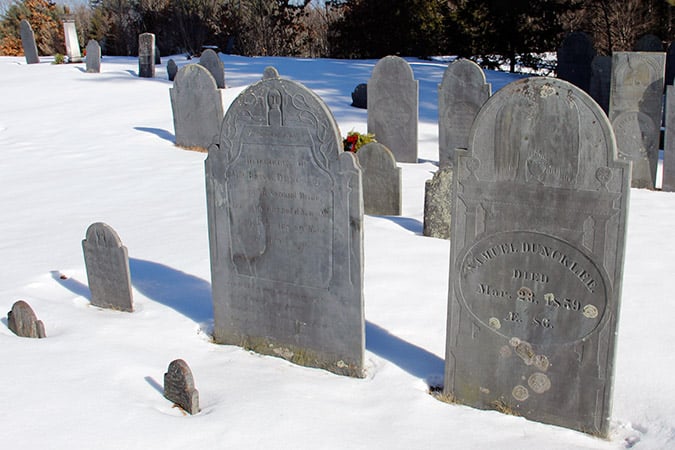
Photo Credit : Brenda Darroch
Spirit faces peer out from the older slabs, and sharp-eyed observers may notice that many graves are bordered by both a headstone and footstone. According to the religious beliefs of the time, these plots were designed to mimic the head and footboard of a bed, because they were seen as temporary resting spots until the resurrection of Christ.
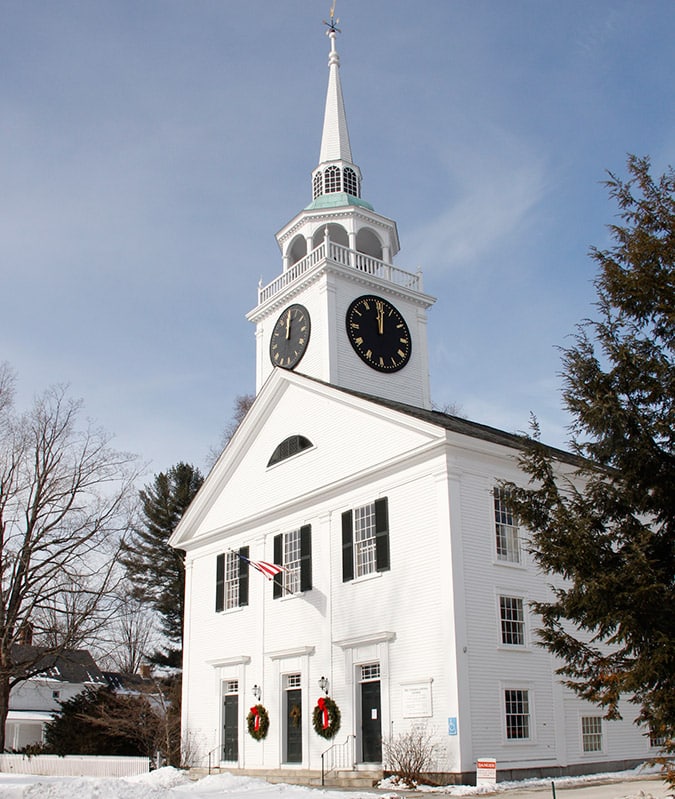
Photo Credit : Brenda Darroch
Just as the Common anchors the village, the Second Meetinghouse moors the Common. At the time of its construction in 1774, it was actually set on the Common. The town sold the Meetinghouse to the First Congregational Church and Society in 1832, retaining ownership of the clock tower and rights to conduct meetings on site. The building was moved to the other side of Church Street in 1836 and remains a congregational church today.

Photo Credit : Darroch, Brenda
The Soldiers’ Monument stands on a slice of land that separates Church Street from Middle Street. Erected in 1871 to honor the twenty-five soldiers from Amherst who lost their lives in the Civil War, this bronze monument depicts a Union infantryman, his head bowed in contemplation.
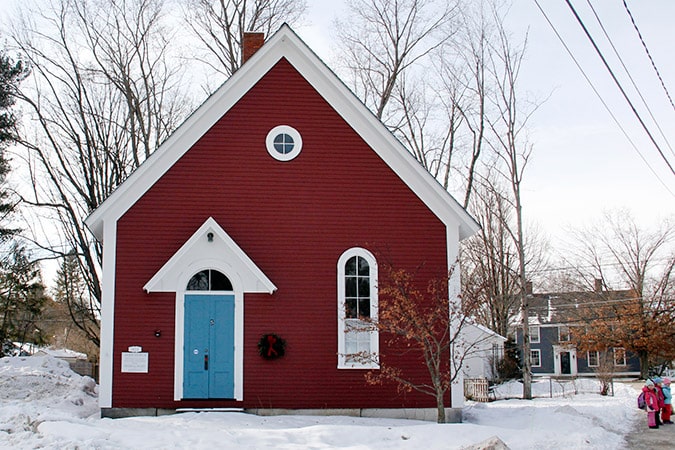
Photo Credit : Brenda Darroch
Originally built as a vestry for the First Congregational Church and Society in 1858, the Chapel Museum is one of two museums maintained by the Historical Society today.

Photo Credit : Brenda Darroch
Right next door on the corner of School Street and Middle Street, the Brick School served as a public school from 1854 until 1967.
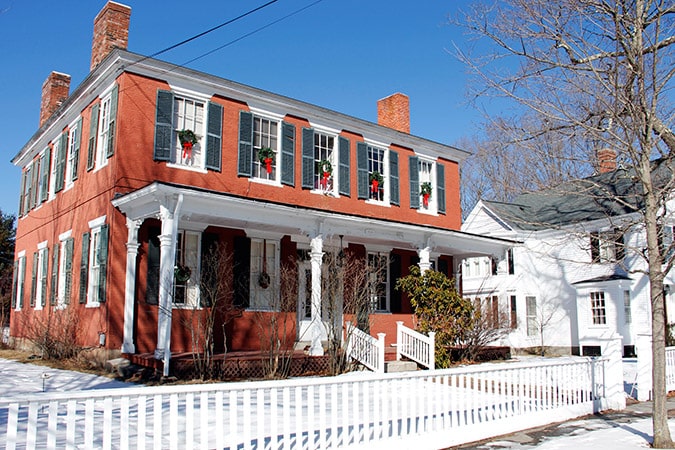
Photo Credit : Brenda Darroch
Swoop down School Street, and you’ll find the Hillsborough Bank Building, whose claim to nefarious fame was issuing more notes and loans than its meager reserves could cover. The result: suspension of payments, a flurry of lawsuits, and a bundle of worthless bank notes — a mere three years after the bank’s incorporation.
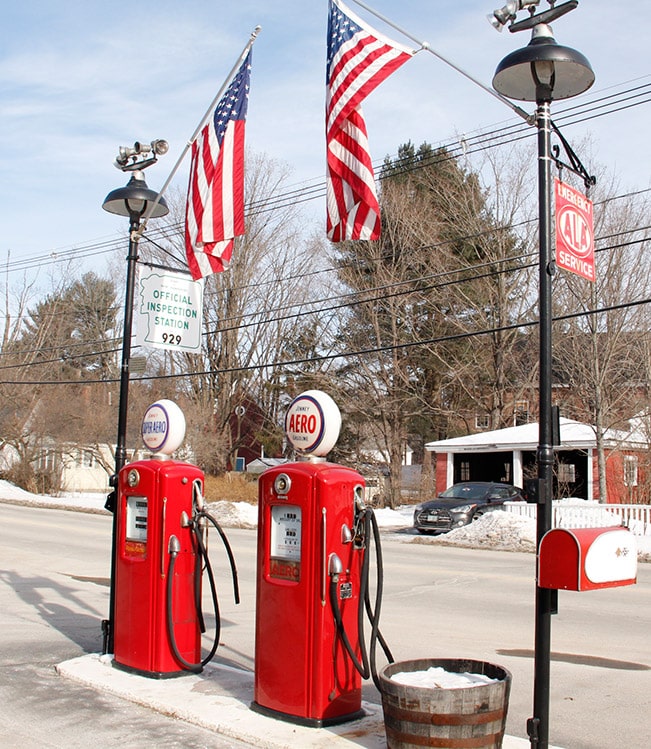
Photo Credit : Brenda Darroch
Turn the corner and your eye will be caught by the cherry red gas pumps at Mike’s Auto Service. The fully-operational Jenney pumps, which predate the 1940s but were restored in 1994, are fairly new in historic Amherst terms, but they tug at the nostalgic heartstrings nonetheless.
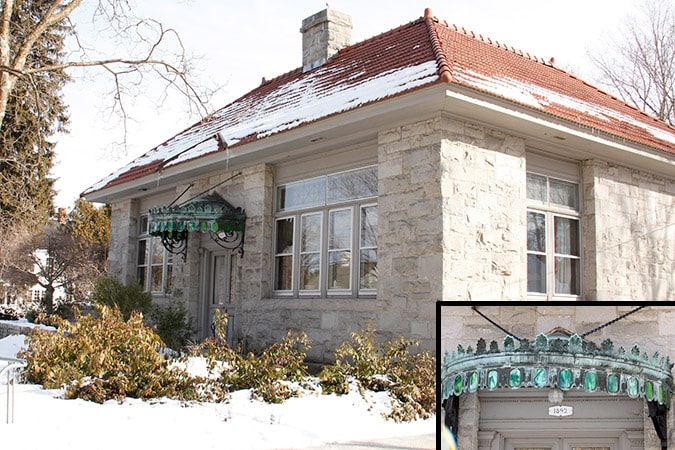
Photo Credit : Brenda Darroch
Turning back toward Main Street, we passed the town library, pausing to admire its copper canopy adorned with green swirls of glass.
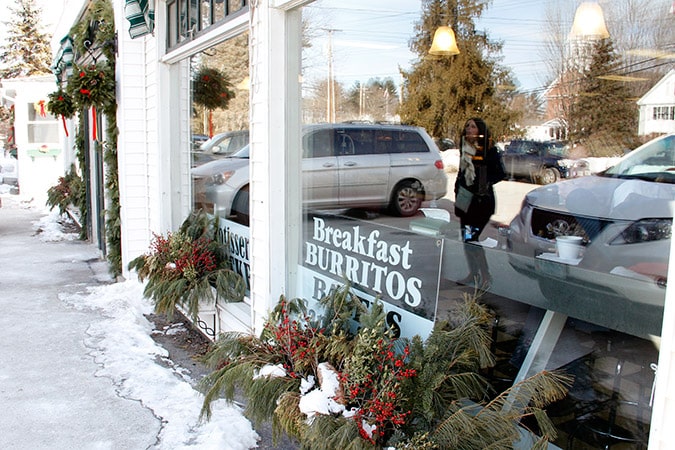
Photo Credit : Brenda Darroch
Having toured the Common, the village’s landmarks, and many of the side streets, we were ready to pop into Moulton’s Market — a small grocery store and deli — for a bite to eat. Now a bustling gathering place for locals, the market sits on the site of “Cushing’s Folly,” a three-story brick building that housed a variety of businesses from its inception in 1809 until being razed by fire in 1948.
After warming up in Moulton’s, we were less eager to subject ourselves to the frigid temps and chose to curtail our sightseeing tour. To appreciate the historic offerings of Amherst, New Hampshire, in their entirety, plan to spend a full day walking around the village.

Photo Credit : Alyson Horrocks
Have you ever visited historic Amherst, New Hampshire?
This post was first published in 2014 and has been updated.








What beautiful photographs! I was lucky enough to be in Amherst last year during the big snowstorm. I love to visit the area in any season…truly a beautiful oasis.
Amherst is such an amazing Villiage and your host, Alyson, is even more amazing! Great photos!!
Alyson was a wonderful guide, Emily. She’s so much fun!
You may also enjoy these museum quality images of Amherst and other beautiful NH towns on my website:
http://jefpix.smugmug.com/JeffsBest/Architecture
Jeff Hall Photography
Here’s my gallery dedicated solely to Amherst architecture:
http://jefpix.smugmug.com/Architecture/Amherst-Area-Buildings
Jeff Hall Photography
Those are lovely, Jeff!
Next time I hope to visit Amherst, New Hampshire in warmer weather, Vicki.
Thank you very much for a wonderful write up and beautiful pictures of Amherst. I’m a native to New Hampshire, born and raised in Nashua, and I would visit Amherst during my childhood years and always enjoying the area and wanting to one day live in this town. Well, the “one day” finally materialized about 15 years ago and I have not regretted one moment of my decision, except that I am still not liking the cold and frigid winter months. Again, Thank you!!!
I was fortunate and proud to be born and raised in this wonderful town! It will forever be one on the BEST small New England Towns!
I really enjoyed this lovely piece–and the pictures really bring it alive. I attended Mount Holyoke for college and spent some hours in the Amherst library, but never really saw the town and these landmarks. Your photos and observations help me to “see” what I probably passed by. Thank you!
Would love to see pics of Halloween festivities. Thanks!
This is my home town, I was raised here and attended all the schools in your photos and frequented each location in your article; it’s where I grew up! Started at the Clark School in 1958, then went to the Brick School (the little red museum was the building we called “The Annex” and we held music classes over there. Each week we made trips to the library from there. We had to march across the common to have ‘hot lunch’ in the Town Hall building. My career at Yankee Publishing spanned nearly 17 years from 1973 to 1989. While on vacation a few years ago I met up with Jud Hale in Gilford at one of the local eateries. . Best memories of my life are from those years at Yankee…
Wasn’t to hard to figure out who this was, Amherst was a great town to growin
Amherst Village at Halloween is the greatest. My kids look forward to it every year.
Those from away may enjoy the Historical Society’s blogsite that posts a variety of Amherst Village photography. They also have a website with a slide show available at: http://www.amhersthistoricalsociety.com
Hey Jeff, do you have any photos of my house at 89 Boston Post Rd?
Catherine, are you sure you aren’t thinking of Amherst, Massachusetts? I grew up in Amherst, NH and went to school for a couple years at UMass in Amherst, MA (near Mt Holyoke College). They are often confused . . . and it would explain why the landmarks don’t look familiar 🙂
Although I live in the Southeast now, Amherst will always be home.
Amherst will always be my home. Lived there for 40 years and loved it so much and after 8 years of living in Florida, I still consider Amherst to be the best place to live. Wonderful quaint town and great people.
My husband and I will be moving back east for his job. We have two kids (3 and 1) and 3 dogs. We are looking for a nice place to live. We currently live in a small town in Southern California. My husband will be traveling for work but also working out of Boston. I know that I definitely don’t want to live in the hustle and bustle of the city and my husband doesn’t mind a commute. I have been looking everywhere for some reviews or comments about a great, safe place to move and raise our kids. I have fallen in love with Amherst (NH) through pictures and the few things I have found to read. Does anyone else have any insights? Suggestions? Other places they might recommend? I would really love to know more about Amherst though. It will be a big move for us and I want to know as much as we can before we make a journey out to look at places and houses. Thank you so much!
Amherst is a beautiful town but it will be a long journey to Boston. Bedford or Hollis will be closer
Bedford or Hollis will knock off maybe 15 mins to the commute. We have two kids (5 and 2) and absolutely love it. It’s a very safe town. It’s quiet and laid back, but near everything you need. The schools are great, there is a great local park for kids, and it borders Milford which has a nice oval full of mom and pop shops including The Loft for lunch or dinner and riverview diner for an amazing breakfast.
Kim, I live in SoCal, too but used to live in Bedford, NH and commute to Boston, which is not difficult, except during a blizzard. Bedford is a lovely town with some good restaurants and lots of open space. Hope you enjoy your time there. The people are the salt of the earth and I miss them. You will make lots of good friends.
Beautiful pictures. Amherst has so many great spots to visit.
Oh my! What beautiful pictures that tell such a story! I am from NH but have been away for 30+ years…I am currently sitting in a small, ugly town in Oklahoma…there isn’t much beyond New England that brings pride, quaintness, and joy to the eyes and heart.
I AM moving back home as soon as I can..
I attended 1st grade in the Brick School House back in 1954. When my Dad passed away in 1994 my brothers and I went for a visit. The staff working there now let us roam around and look. Amherst is a great town.
The article doesn’t mention the high taxes in this town. The schools are mediocre and suck up more than 80% of our taxes.
You’ll get a bigger bang for your buck living in nearby Bedford or Hollis.
You are misinformed. It has one of the best school districts in all of NH. I don’t mind paying a higher tax if it goes towards something good. Also, the article didn’t fail to mention that. It wasn’t the point of the article. It’s point was the history the town holds and it did a great job at that. Take your nonsense somewhere else.
I grew in Amherst 50’s & 60’s , I’ve been to 5 Continents, 38 Countries, Amherst is one of the most beautiful villages on this planet. My ancestors go back to the 1740’s in Amherst NH
The 1-23-18 comment about the taxes is accurate. They are high, and the school system is not as great as some believe because the standards aren’t high enough. Most homes are expensive. Still, I love the town, and the area is just wonderful. Hollis is beautiful, too.
I grew up in Amherst and it is a beautiful town. I miss it so. After the 1960s the Brick School became the public kindergarten. I remember going there and then when I got to high school in the 80s having to transfer busses at that location to get to MASH (Amherst High School was created after I graduated.)
Can you tell me at one time Vine st. In Milford NH was know as Amherst NH
Bring a fat wallet!
Your article about Amherst NH returned me to memories of Westford MA and its town green which still has an elm tree or two, beautiful churches, , the library and town hall. Westford also is among the highest in elevation of any eastern MA town, home to Harvard’s observatory. So many more things to love about Westford, lots of ponds and beaches, a quaint village (Nabnasset), an ancient carved stone with medieval associations and friendly folks: I miss it so! Please do a profile!
I grew up in Amherst with my bestie, Beth and Corrine. I got married in that church, had my first child. Then moved away and have never gone back as much as I would love to. We lived on Beaver Brook Circle
My dad, Richard Maxner and the gang, Duncan Polson and Ken Cannaday usedntonflood the Commons in the winter so all us kids could go ice skating. So many great memories. Love Amherst